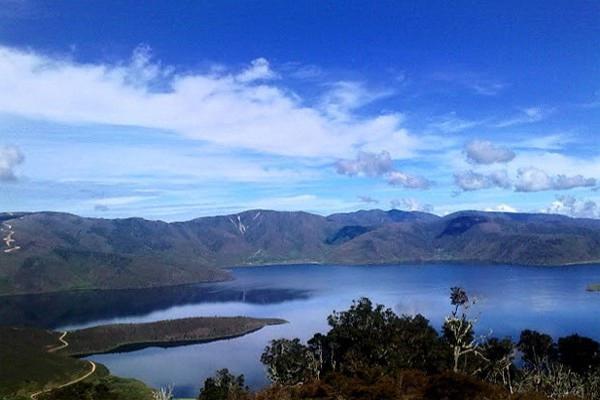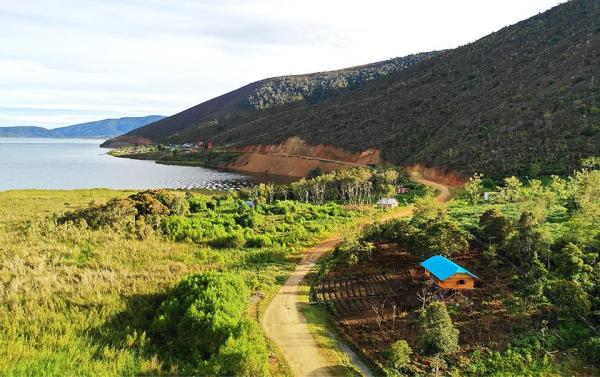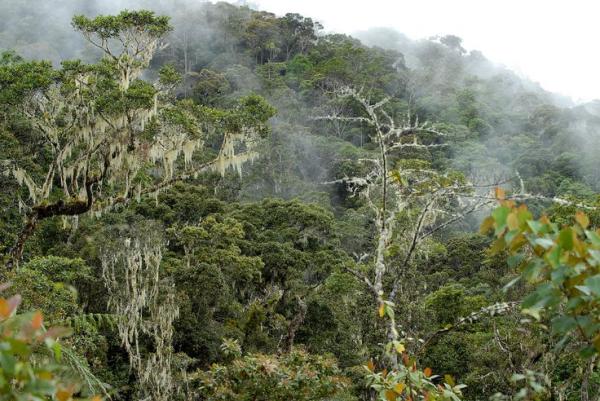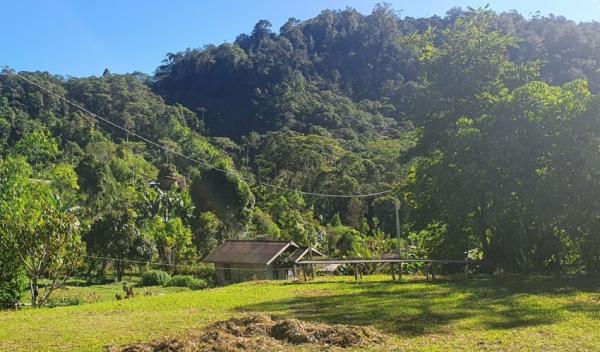Arfak Mountains: Known for its biodiversity and birdwatching opportunities

The Arfak Mountains are one of Papua New Guinea's most intriguing natural treasures, but they are also a stunning part of Indonesia, offering some of the most untouched and awe-inspiring landscapes in the world. Located in the Bird's Head Peninsula of Papua Province, this mountain range is famous for its biodiversity, cultural significance, and stunning natural beauty. From trekking to bird watching, here are some of the most unforgettable things to do in the Arfak Mountains:
1. Bird Watching in the Arfak Mountains
The Arfak Mountains are known for their rich avian life, particularly for birdwatching enthusiasts. This region is home to various endemic species, many of which are not found anywhere else on Earth. The diverse landscapes, from lush rainforests to high-altitude grasslands, make it an ideal habitat for an array of bird species.
- Endemic Species to Look For:
- Wilson's Bird-of-Paradise: This colorful bird is one of the most sought-after species for bird watchers. Its vibrant plumage and intricate courtship display make it a fascinating sight.
- King Bird-of-Paradise: Known for its flamboyant feathers, this bird is another gem of the region.
- Yellow-billed Lorikeet: This bright, colorful bird is another common sight in the forested areas of the Arfak Mountains.
- Other Notable Species: You may also spot species such as the Black-capped Lory, the Lesser Bird-of-Paradise, and various species of pigeons and parrots.
Birdwatching in this region requires some planning and patience, as some birds, like the birds of paradise, have specific habitats and mating rituals that require careful timing and expert knowledge.
2. Trekking and Hiking
The rugged terrain of the Arfak Mountains makes it an excellent destination for trekking and hiking. Whether you're an experienced adventurer or a novice, there are trails suited to various fitness levels. The hikes often lead you through dense tropical forests, high-altitude grasslands, and across breathtaking mountain ridges. Here are a few trekking highlights:
- The Summit Trek: The highest peak in the Arfak Mountains is Mount Arfak, which rises to 2,950 meters (9,678 feet). The summit offers panoramic views of the surrounding mountains, valleys, and the sea. Reaching the summit requires a multi-day trek, but the stunning landscapes and sense of achievement make it worthwhile.
- Jalur Gunung Hiking Trails: These trails take you through dense rainforests, where you can explore the diverse flora and fauna of the region. The trails vary in difficulty, so hikers of all experience levels can find suitable routes.
- Waterfall Treks: Many trekking routes pass by or lead to hidden waterfalls. These remote waterfalls are surrounded by untouched wilderness, providing a serene and beautiful atmosphere for those who venture to see them.

3. Cultural Exploration and Indigenous Communities
The Arfak Mountains are home to several indigenous Papuan tribes, each with its own unique culture and traditions. Visiting these communities provides an excellent opportunity to learn about the indigenous way of life and their close connection to nature.
- Interacting with the Local Tribes: The native inhabitants of the Arfak Mountains are primarily from the Arfak and other nearby tribes. Their villages are often located at the foot of the mountains, where they engage in traditional agricultural practices, hunting, and fishing. Visitors can observe their daily life, participate in traditional rituals, and enjoy local food.
- Traditional Art and Craft: Many indigenous communities in the Arfak Mountains are skilled in weaving, carving, and creating intricate artworks. These crafts are used for daily life and ceremonial purposes. Visitors can purchase hand-made products, such as baskets, wooden carvings, and jewelry, as souvenirs.
- Tribal Ceremonies: Depending on the time of year, you might have the chance to witness a local ceremony or festival. These events often feature traditional dances, music, and rituals that highlight the cultural heritage of the region.
4. Visiting the Vogelkop Peninsula
The Arfak Mountains are part of the larger Vogelkop Peninsula, which is a haven for biodiversity and natural beauty. If you venture further into the peninsula, there are several places to visit:
- Lake Anggi Giji: A beautiful high-altitude lake nestled between two mountains. The lake is a great place for boating, fishing, and swimming, surrounded by scenic views of the mountains.
- Anggi Gita: A hidden lake near the village of Anggi, this lake is accessible by a challenging hike, making it a great option for adventure seekers.
- Bird Watching at Kaimana: For those who want to explore more of the peninsula's birdlife, Kaimana is another great spot for bird watching, particularly for marine and coastal species.
5. Exploring Flora and Fauna
The Arfak Mountains are known for their diverse ecosystems, ranging from dense tropical rainforests to alpine meadows, making it a biodiversity hotspot. Beyond the birds, there are a variety of other animal species and plant life to discover.
- Mammals: Visitors may spot some of the region's larger mammals, such as the cuscus (a type of marsupial), various species of monkeys, and even rare wild pigs.
- Reptiles and Amphibians: The forests and wetlands around the Arfak Mountains are home to several species of reptiles and amphibians, including colorful frogs and the elusive tree-dwelling lizards.
- Plant Life: The forests are home to many species of endemic plants, including unique orchids, ferns, and trees that are adapted to the region’s tropical climate. The flora of the Arfak Mountains is especially diverse in the higher altitudes, where alpine plants thrive.

6. Photography and Nature Exploration
The landscape of the Arfak Mountains is a photographer’s paradise. From the mist-covered peaks to the lush valleys below, there are endless opportunities to capture the wild beauty of the region. The towering trees, vibrant wildlife, and sweeping vistas provide rich subjects for both amateur and professional photographers.
- Sunrise and Sunset Views: For the best shots, make sure to wake up early or stay late to witness the breathtaking sunrises and sunsets over the peaks and valleys of the Arfak Mountains.
- Night Photography: The dark skies over the mountains are perfect for astrophotography. The remote location offers little light pollution, allowing for clear views of the stars and even the Milky Way on certain nights.
7. Eco-Tourism and Sustainable Travel
As a part of the broader conservation efforts in Papua, many eco-tourism initiatives have been launched in the Arfak Mountains. These efforts aim to protect the unique environment of the region while benefiting local communities. Visitors who choose to engage with eco-friendly tour operators contribute to the preservation of the area’s biodiversity and support sustainable economic development for the indigenous people.
8. Practical Tips for Visiting the Arfak Mountains
- Access: The most common way to reach the Arfak Mountains is by flying into Manokwari, the capital of West Papua Province, and then taking a local flight or overland transport to the base of the mountains.
- Weather: The climate in the Arfak Mountains can be quite variable, with cool temperatures at higher altitudes and humid conditions at lower elevations. Visitors should be prepared for rainy weather, especially during the wet season (from November to March).
- Accommodation: There are basic lodges and homestays in the area, many of which are run by local communities. For more comfortable options, Manokwari offers some hotels and guesthouses.
- Guides: Hiring a local guide is recommended for trekking, bird watching, and cultural visits. Local guides can provide valuable insight into the wildlife, landscape, and culture, enhancing the overall experience.
9. Adventure Activities: Paragliding and Mountaineering
The Arfak Mountains offer more than just hiking and birdwatching. For thrill-seekers, there are a few exciting adventure activities to try, including paragliding and mountaineering. The steep cliffs and high ridges of the Arfak Mountains provide perfect conditions for these adrenaline-pumping sports.
- Paragliding: While not yet as widely known as destinations like Bali or Java, the Arfak Mountains' landscape is ideal for paragliding. The stunning mountain views, combined with the clear skies, make it an extraordinary experience to fly over the valleys and forests. This activity requires a local guide and experienced paragliding instructors who know the best launch sites and conditions.
- Mountaineering: For mountaineers, the Arfak Mountains offer several peaks to climb, including challenging ascents that require skill and experience. While Mount Arfak (2,950 meters) is the highest, other notable peaks, such as Mount Nggap and Mount Pinang, are also popular among climbers. These peaks provide technical challenges and spectacular views for those looking to push their limits in the wild.
10. Caving and Exploration of Karst Formations
In addition to the high mountains, the Arfak region is also home to fascinating limestone formations and caves that attract spelunkers and those interested in geology. These karst landscapes offer opportunities for cave exploration, where visitors can uncover hidden subterranean chambers, stalactites, and stalagmites.
- Caves in the Arfak Mountains: Many caves are tucked away in the folds of the mountains, offering a quiet and isolated experience. Some of these caves have prehistoric significance, and visitors can view ancient rock art that tells the story of the indigenous peoples who lived in the region thousands of years ago.
- Cave Tours: Local guides, many of whom are from the indigenous communities, can lead visitors through these caves. A few caves are easily accessible, while others require trekking through dense forests or along riverbeds to reach their entrances.
11. River Expeditions and Canoeing
The rivers that flow through the Arfak Mountains are not only important for the region's biodiversity but also offer unique opportunities for water-based adventures. Canoeing or kayaking on these remote rivers provides a peaceful way to experience the lush surroundings and observe wildlife from the water.
- Rivers to Explore: The Anggi River and its tributaries are some of the most notable water routes for exploration. Canoeing along the river, you can often spot bird species, such as hornbills, as well as aquatic life like fish and freshwater turtles.
- Fishing: For those interested in fishing, the Arfak’s rivers and lakes provide an abundance of fish species, including some that are endemic to the area. The local indigenous people often practice traditional fishing methods using nets, and visitors can experience these techniques firsthand.

12. Mountain Biking in the Arfak
For those who prefer exploring on two wheels, the Arfak Mountains also offer a great option for mountain biking. The terrain is rugged, with steep slopes, rocky paths, and forested trails that are perfect for off-road biking. Riders can enjoy the thrill of downhill biking while soaking in the beautiful scenery.
- Trail Networks: Local guides can help you navigate the mountain biking trails. Many of these trails connect different villages and take you through lush jungles, streams, and along mountain ridgelines.
- Challenges and Rewards: Biking in the Arfak Mountains is not for the faint of heart; the challenging terrain and steep inclines require stamina and skill. However, the sense of accomplishment, coupled with the incredible views, makes this activity highly rewarding.
13. Camping and Stargazing
For a truly immersive experience in nature, camping in the Arfak Mountains is an excellent way to connect with the wilderness. There are many scenic spots where visitors can set up camp, whether it’s by the edge of a river, near a waterfall, or at a high-altitude campsite with panoramic views of the mountains.
- Campsites: Many of the trekking routes and bird watching tours offer designated campsites along the way. For those who want a more rustic experience, camping can be arranged with local guides. Camping in these remote locations allows you to witness the stars like never before, as the absence of artificial light results in incredible stargazing opportunities.
- Stargazing: Due to the lack of light pollution, the Arfak Mountains offer excellent conditions for stargazing. You can see a myriad of stars, planets, and constellations with the naked eye. If you're interested in astrophotography, the high-altitude locations provide a pristine environment to capture stunning celestial scenes.
14. Cultural and Culinary Experiences
Exploring the Arfak Mountains isn’t just about nature—it’s also an opportunity to dive into the rich cultural tapestry of the indigenous peoples. The local communities have maintained traditional practices for centuries, and food is an important part of their culture.
- Traditional Cooking: One of the best ways to experience the culture of the Arfak Mountains is through the food. Indigenous people traditionally use locally sourced ingredients, including root vegetables like yam, various types of bananas, wild meats, and freshly caught fish. You might get the opportunity to participate in cooking demonstrations, learning how to prepare local dishes such as papeda (a traditional sago dish), grilled fish, and stews.
- Visiting Markets: In the towns and villages near the Arfak Mountains, visitors can find traditional markets where indigenous people sell fresh produce, fish, handicrafts, and woven goods. Visiting these markets provides an authentic glimpse into local life, as well as an opportunity to purchase unique souvenirs.
- Cultural Festivals: Depending on when you visit, you may be lucky enough to coincide with a local cultural festival or ceremony. These events can feature music, dancing, and vibrant rituals. Participation in or observation of these celebrations offers deep insight into the spiritual and cultural traditions of the Arfak tribes.
15. Conservation and Sustainability Efforts
The Arfak Mountains are not only an exceptional natural destination, but they also represent the forefront of conservation efforts in Papua. With its unique biodiversity, the area is part of several environmental protection initiatives that aim to preserve the natural habitats, wildlife, and indigenous cultures.
- Conservation Areas: Some parts of the Arfak Mountains are designated as protected areas, ensuring the preservation of habitats critical to the survival of species like the birds-of-paradise. Conservation organizations work closely with local communities to promote sustainable tourism, conduct research, and prevent deforestation.
- Eco-Friendly Travel: Eco-tourism in the Arfak region is becoming increasingly popular, with travelers encouraged to engage in low-impact activities that help preserve the environment. Travelers can choose to stay in eco-friendly lodges, reduce waste, and follow sustainable practices that ensure the region’s natural beauty and cultural heritage are preserved for future generations.
16. Seasonal Highlights: Best Time to Visit
The best time to visit the Arfak Mountains depends on what kind of experience you’re seeking, as weather conditions can vary across seasons.
- Dry Season (May to October): The dry season is generally considered the best time to visit, especially for outdoor activities like trekking, bird watching, and paragliding. This period offers milder temperatures and less rain, making the trails more accessible.
- Wet Season (November to April): While the wet season brings heavier rainfall and more challenging conditions for trekking, it can be a great time to visit if you want to see the lush landscapes in their full splendor. Bird watching can also be fantastic during this period, as it coincides with the breeding season for many species.
Conclusion
The Arfak Mountains offer an exceptional array of activities and experiences that blend adventure, culture, and nature. From trekking in remote jungles and summiting peaks to immersing yourself in indigenous cultures and witnessing rare wildlife, the region is an explorer’s dream. Whether you’re an adrenaline junkie, a nature lover, or a cultural enthusiast, the Arfak Mountains provide a rich, unforgettable experience that is hard to find elsewhere in the world.
No comments yet. Be the first to add a review.